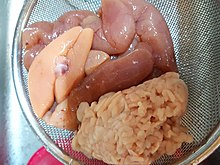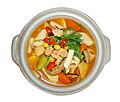Pollock roe
| Alaska pollock roe | |||
|---|---|---|---|
 | |||
| Korean name | |||
| Hangul | 명란 | ||
| Hanja | 明卵 | ||
| Literal meaning | Alaska pollock roe | ||
| |||
| Japanese name | |||
| Kanji | 鱈子 | ||
| Kana | たらこ | ||
| |||
| Russian name | |||
| Russian | икра минтая | ||
| Romanization | ikra mintaya | ||
Pollock roe, also pollack roe, (also known as myeongnan and tarako) is the roe of Alaska pollock (Gadus chalcogrammus) which, despite its name, is a species of cod. Salted pollock roe is a popular culinary ingredient in Korean, Japanese, and Russian cuisines.
Names[]
In Korean, pollock roe is called myeongnan (명란), while the salted roe dish is called myeongnan-jeot (명란젓), being considered a type of jeotgal (salted seafood). The Korean word myeongnan (명란) means pollock roe as myeong (명) came from myeongtae (명태), the Korean word for Alaska pollocks, and ran (란), also pronounced nan, means "egg (roe)". As jeot (젓) is a category of salted seafood, the compound myeongnan-jeot (명란젓) refers to salted pollock roe.
The Japanese word for the pollock roe is called tarako. The pollock food products are often called, karashi-mentaiko or mentaiko is a compound of mentai (明太), borrowed from its Korean cognate myeongtae meaning Alaska pollock, and ko (子), a Japanese word for "child (roe)". Alaska pollocks are called suketōdara (介党鱈) in Japanese. Tara (鱈) means cod in Japanese. Tarako (鱈子) literally means "cod roe", but generally refers to smaller salted roe sacs.[1]
In Russian, pollock roe is called ikra mintaya (икра минтая). The word is also used to referred to the salted roe. The Russian word ikra (икра) means "roe" and mintaya (минтая) is the singular genitive form of mintay (минтай), which means Alaska pollock. The word also derived from its Korean cognate, myeongtae (명태).
History[]
Korea[]
Koreans have been enjoying pollock roe since the Joseon era (1392–1897). One of the earliest mentions are from Diary of the Royal Secretariat, where a 1652 entry stated: "The management administration should be strictly interrogated for bringing in pollock roe instead of cod roe."[2] Recipe for salted pollock roe is found in a 19th-century cookbook, Siuijeonseo.
Japan[]
A 1696 Japanese book records the use of Alaska pollock's roe in Northern land.[3]
The dish mentaiko originates from Korea and is originally the Korean myeongnan-jeot.[4][5][6][7][8][9] Toshio Kawahara (川原 俊夫, Kawahara Toshio), who was born in the city of Busan, Korea during the Japanese occupation, founded the oldest mentaiko company in Japan called "Aji no Mentaiko Fukuya" (ja:ふくや) after World War II. He made slight modifications to myeongnan-jeot to adapt to Japanese tastes and introduced it to Japan as "Karashi mentaiko" (ja:辛子明太子), its popular name is "mentaiko". The milder, less spicy version is called tarako (鱈子) in Japan.
Salted pollock roe[]
 | |
| Alternative names | Myeongnan Myeongnan-jeot Tarako Mentaiko Ikra mintaya |
|---|---|
| Type | Jeotgal |
| Course | Banchan |
| Place of origin | Korea |
| Associated national cuisine | Korean cuisine Japanese cuisine Russian cuisine |
| Main ingredients | Roe of Alaska pollock |
| Salted Alaska pollock roe | |||
|---|---|---|---|
| Korean name | |||
| Hangul | 명란젓 | ||
| Hanja | 明卵- | ||
| Literal meaning | Alaska pollock roe jeotgal | ||
| |||
| Japanese name | |||
| Kanji | 鱈子/(辛子)明太子 | ||
| Kana | たらこ/(からし)めんたいこ | ||
| |||
| Russian name | |||
| Russian | икра минтая | ||
| Romanization | ikra mintaya | ||
Korea[]
Traditionally, myeongnan-jeot was made before dongji (winter solstice). Intact skeins of Alaska pollock roe are washed carefully with salt water, then salted in a sokuri (bamboo basket). The ratio of salt to roe ranges from less than 5:100 to more than 15:100. After 2–3 days, salted and drained roe is marinated for at least a day with fine gochutgaru (chilli powder) and finely minced garlic. myeongnan-jeot is usually served with some drops of sesame oil.
Myeongnan-jeot, whether raw, dried, and/or cooked, is a common banchan (side dish) and anju (food served with alcoholic beverages). It is also used in a variety of dishes, such as gyeran-jjim (steamed egg), bokkeum-bap (fried rice), and recently in Korean-style Italian pasta dishes.
Myeongnan-jeot is a specialty of South Hamgyong Province of North Korea, and Gangwon Province and Busan of South Korea.

Myeongnan-jeot sold in a market

Vacuum-packed myeongnan-jeot

Heavily seasoned myeongnan-jeot

Myeongnan-jeot-muchim (salted pollock roe salad)

Myeongnan-jeot-gyeran-mari (rolled omelette with salted pollock roe)

Myeongnnan-jeot in jjigae (stew)

Myeongnan-jeot pizza
Japan[]
Mentaiko, adapted from Korean myeongnan-jeot,[10][11][12][7][13][14] hence the name mentai myeongtae (명태,明太, pollack) + ko(알, 子, baby or roe)], is common in Japan. It is made in a variety of flavors and colors and is available at airports and main train stations. It is usually eaten with onigiri, but is also enjoyed by itself with sake. A common variety is spicy mentaiko (辛子明太子, karashi mentaiko). It is a product of the Hakata ward of Fukuoka City. Milder version is called tarako (鱈子),
Recently in Japan, mentaiko pasta has become common. Mentaiko is mixed with butter or mayonnaise and used as a sauce for spaghetti. Thin strips of Nori are often sprinkled on top.
Mentaiko was nominated as Japan's number one side dish in the Japanese weekly magazine, Shūkan Bunshun.[15]
Tarako is served in a number of ways: plain (usually for breakfast),[16] as a filling for onigiri, and as a pasta sauce (usually with nori). Traditionally, tarako was dyed bright red, but recent concerns about the safety of food coloring have all but eliminated that custom.[16] In Kyūshū, tarako is commonly served with red chili pepper flakes.

Tarako

Mentaiko

Baked mentaiko

Mentaiko-chazuke

Mentaiko spaghetti

Tarako spaghetti
Russia[]
In Russia, pollock roe is consumed as a sandwich spread. The product, resembling liquid paste due to the small size of eggs and oil added, is sold canned.

Ikra mintaya spread
See also[]
- Alaska pollock as food
- Jeotgal
- Masago
- Tobiko
References[]
- ^ Gleyn, Bledsoe; Barbara, Rasco (2006). "Caviar and Fish Roe". In Hui, Yiu H. (ed.). Handbook of Food Science, Technology, and Engineering. CRC Press. p. 161-12. ISBN 978-0-8493-9849-0. Retrieved 11 March 2020.
- ^ Cha, Sang-eun (12 September 2015). "A hit abroad, pollock roe is rallying at home". Korea Joongang Daily. Retrieved 16 December 2016.
- ^ "遠藤元閑(1696年)『茶湯献立指南』、「鱈の子は北国より出る名物也」" (JPG). Archive.wul.waseda.ac.jp. Retrieved 15 May 2018.
- ^ "Jacar Newsletter No. 19". Jacar.gp.jp. Retrieved 15 May 2018.
- ^ "Marinated Mentaiko Cod Roe - Authentic Japanese product". Japan-brand.jnto.go.jp. Retrieved 15 May 2018.
- ^ Preston, Matt (27 October 2015). The Simple Secrets to Cooking Everything Better. Plum. ISBN 9781743547618. Retrieved 15 May 2018 – via Google Books.
- ^ Jump up to: a b "Karashi Mentaiko (Marinated Pollack Roe". Kyushu Tourism Information. Retrieved 15 May 2018.
- ^ "Mentaiko! - The Japanese Food Report". Japanesefoodreport.com. Retrieved 15 May 2018.
- ^ "Mentaiko Spaghetti Recipe (明太子)". Japanesefoodreport.com. 18 September 2014. Retrieved 15 May 2018.
- ^ "Archived copy". Archived from the original on 2017-10-14. Retrieved 2017-10-14.CS1 maint: archived copy as title (link)
- ^ "Marinated Mentaiko Cod Roe - Authentic Japanese product". Japan-brand.jnto.go.jp. Retrieved 21 December 2017.
- ^ Preston, Matt (27 October 2015). The Simple Secrets to Cooking Everything Better. Plum. ISBN 9781743547618. Retrieved 21 December 2017 – via Google Books.
- ^ "Mentaiko! - The Japanese Food Report". Japanesefoodreport.com. Retrieved 21 December 2017.
- ^ "Mentaiko Spaghetti Recipe (明太子)". Sffood.net. 18 September 2014. Retrieved 21 December 2017.
- ^ Ahn (안), Min-jeong (민정) (May 6, 2011). 일본인 좋아하는 밥반찬에 한국의 그것? (in Korean). JPNews. Archived from the original on November 22, 2011. Retrieved November 19, 2016.
- ^ Jump up to: a b Ashkenazi, Michael; Jacob, Jeanne (2003). "Major Foods and Ingredients". Food Culture in Japan. Greenwood Publishing Group. pp. 58–9. ISBN 0-313-32438-7.
External links[]
 Media related to Pollock roe at Wikimedia Commons
Media related to Pollock roe at Wikimedia Commons
- Japanese seafood
- Jeotgal
- Korean cuisine
- Roe
- Korean seafood













